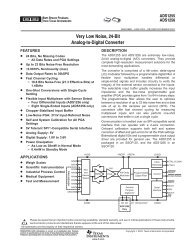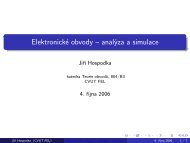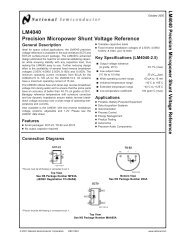LTC2410 24-Bit No Latency âΣTM ADC with Differential Input and ...
LTC2410 24-Bit No Latency âΣTM ADC with Differential Input and ...
LTC2410 24-Bit No Latency âΣTM ADC with Differential Input and ...
You also want an ePaper? Increase the reach of your titles
YUMPU automatically turns print PDFs into web optimized ePapers that Google loves.
<strong>LTC<strong>24</strong>10</strong>APPLICATIO S I FORATIOU W U Usynchronized <strong>with</strong> an outside source, the <strong>LTC<strong>24</strong>10</strong> canoperate <strong>with</strong> an external conversion clock. The converterautomatically detects the presence of an external clocksignal at the F O pin <strong>and</strong> turns off the internal oscillator. Thefrequency f EOSC of the external signal must be at least2560Hz (1Hz notch frequency) to be detected. The externalclock signal duty cycle is not significant as long as theminimum <strong>and</strong> maximum specifications for the high <strong>and</strong>low periods t HEO <strong>and</strong> t LEO are observed.While operating <strong>with</strong> an external conversion clock of afrequency f EOSC , the <strong>LTC<strong>24</strong>10</strong> provides better than 110dBnormal mode rejection in a frequency range f EOSC /2560±4% <strong>and</strong> its harmonics. The normal mode rejection as afunction of the input frequency deviation from f EOSC /2560is shown in Figure 4.Whenever an external clock is not present at the F O pin, theconverter automatically activates its internal oscillator <strong>and</strong>enters the Internal Conversion Clock mode. The <strong>LTC<strong>24</strong>10</strong>operation will not be disturbed if the change of conversionclock source occurs during the sleep state or during thedata output state while the converter uses an externalserial clock. If the change occurs during the conversionstate, the result of the conversion in progress may beoutside specifications but the following conversions willnot be affected. If the change occurs during the data outputstate <strong>and</strong> the converter is in the Internal SCK mode, theserial clock duty cycle may be affected but the serial datastream will remain valid.NORMAL MODE REJECTION (dB)–80–85–90–95–100–105–110–115–120–125–130–135–140–12 –8 –4 0 4 8 12DIFFERENTIAL INPUT SIGNAL FREQUENCYDEVIATION FROM NOTCH FREQUENCY f EOSC /2560(%)<strong>24</strong>10 F04Figure 4. <strong>LTC<strong>24</strong>10</strong> <strong>No</strong>rmal Mode Rejection WhenUsing an External Oscillator of Frequency f EOSCTable 3 summarizes the duration of each state <strong>and</strong> theachievable output data rate as a function of F O .SERIAL INTERFACE PINSThe <strong>LTC<strong>24</strong>10</strong> transmits the conversion results <strong>and</strong> receivesthe start of conversion comm<strong>and</strong> through a synchronous3-wire interface. During the conversion <strong>and</strong>sleep states, this interface can be used to assess theconverter status <strong>and</strong> during the data output state it is usedto read the conversion result.Table 3. <strong>LTC<strong>24</strong>10</strong> State DurationState Operating Mode DurationCONVERT Internal Oscillator F O = LOW 133ms, Output Data Rate ≤ 7.5 Readings/s(60Hz Rejection)F O = HIGH160ms, Output Data Rate ≤ 6.2 Readings/s(50Hz Rejection)External Oscillator F O = External Oscillator 20510/f EOSC s, Output Data Rate ≤ f EOSC /20510 Readings/s<strong>with</strong> Frequency f EOSC kHz(f EOSC /2560 Rejection)SLEEPAs Long As CS = HIGH Until CS = LOW <strong>and</strong> SCKDATA OUTPUT Internal Serial Clock F O = LOW/HIGH As Long As CS = LOW But <strong>No</strong>t Longer Than 1.67ms(Internal Oscillator)(32 SCK cycles)F O = External Oscillator <strong>with</strong> As Long As CS = LOW But <strong>No</strong>t Longer Than 256/f EOSC msFrequency f EOSC kHz(32 SCK cycles)External Serial Clock <strong>with</strong>As Long As CS = LOW But <strong>No</strong>t Longer Than 32/f SCK msFrequency f SCK kHz(32 SCK cycles)15






